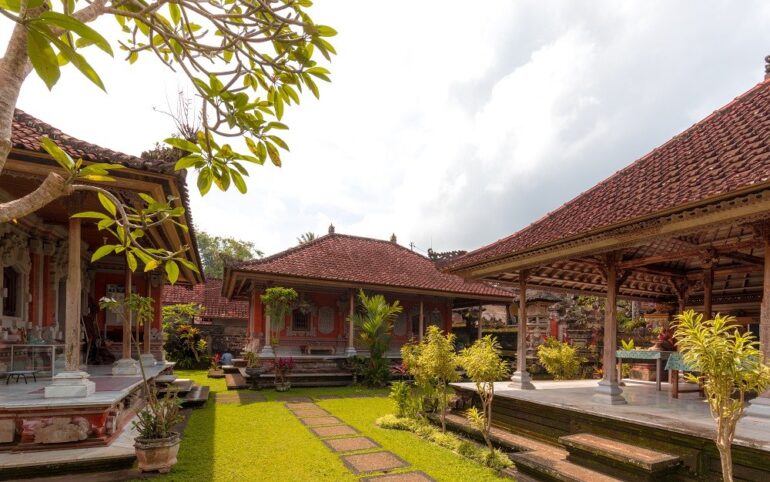
Bali, often known as the Island of the Gods, is renowned for its rich architectural legacy with natural material such as Paras Kerobokan, which represents its dynamic culture and enduring customs. The traditional architecture on the island is a monument to the Balinese people’s affinity for the natural world as well as to the excellent workmanship it displays.
At the heart of Balinese architecture lies a deep appreciation for natural materials. The island’s artisans have long embraced the abundant resources provided by their surroundings, creating structures that blend seamlessly with the lush landscapes.
The following article aims to get into the world of traditional building materials in Bali, shedding light on their historical significance and exploring their role in preserving the island’s cultural identity.
By understanding and appreciating these materials, we can gain insight into the values, beliefs, and sustainable practices that have shaped Balinese architecture over the centuries.
Balinese Traditional Architecture
Balinese architecture is characterized by its harmonious blend of spirituality, functionality, and aesthetic appeal.
Drawing inspiration from Hinduism, the predominant religion in Bali, traditional buildings are designed to create a sacred space that fosters a connection between the divine and the human realm.
The use of intricate carvings, symbolic ornamentation, and spatial arrangements reflects the Balinese people’s devotion and reverence for their beliefs.
Traditional Building Materials
At the heart of Balinese architecture lies the utilization of natural materials, which not only harmonize with the island’s lush landscape but also provide sustainable and eco-friendly building solutions.
Bamboo, thatch, wood, stone, and clay are among the primary materials employed by Balinese artisans to construct their traditional buildings.
Bamboo
The Versatile Wonder Bamboo holds a special place in Balinese culture due to its remarkable versatility. Historically, it has been used for constructing houses, bridges, and even musical instruments.
Bamboo’s strength, flexibility, and rapid growth make it an ideal choice for various structural elements. From ornate entry gates (known as “angkul-angkul”) to intricate roof structures, bamboo showcases its potential in creating unique architectural masterpieces.
Read also : 5 Tips to Go on A Mountain Trip
Thatch
Connecting with Nature Thatch, commonly made from dried grass or palm leaves, is a key roofing material in traditional Balinese architecture. Its insulating properties make it well-suited for Bali’s tropical climate.
Thatched roofs not only provide natural ventilation but also contribute to the overall aesthetics of the buildings, creating a rustic and harmonious atmosphere that complements the surrounding natural environment.
Wood
The Timeless Beauty Wood holds significant cultural and spiritual value in Balinese architecture. The island’s lush forests provide a rich variety of timber, which is skillfully crafted into structural elements, furniture, and decorative carvings.
From intricately carved doors to stunning pavilions, the use of wood adds warmth, elegance, and a sense of timelessness to Balinese buildings.
Stone
One of premium natural stone that is often used as architectural material in Bali is Paras Kerobokan stone. It is a solid type of natural stone, has a hard texture and is suitable for exterior installation.
Solid Foundations Stone, another prominent material in Balinese architecture, represents stability, strength, and endurance. It is extensively used in temple construction and the creation of sacred spaces.
Balinese stone carvers are renowned for their exceptional skills, creating intricate reliefs and statues that adorn temples and palaces throughout the island.
Clay and Terracotta
Earthly Elegance Clay and terracotta hold a special place in Balinese architecture, particularly in decorative elements and pottery.
Craftsmen shape the clay using traditional techniques, resulting in exquisite reliefs, statues, and decorative tiles that embody the island’s artistic traditions. Clay and terracotta add a touch of earthy elegance to Balinese buildings, creating a harmonious blend of natural and man-made beauty.
Sustainability and Preservation
Preserving traditional building materials is crucial in safeguarding Bali’s architectural heritage. While modern construction techniques have gained popularity, efforts are being made to strike a balance between preserving traditional materials such as Paras Kerobokan natural stone and incorporating sustainable practices.
Organizations and initiatives are promoting the use of traditional materials, raising awareness about their cultural importance, and supporting local artisans to ensure the longevity of Balinese architecture.
Conclusion
Exploring the traditional building materials in Bali allows us to delve into the island’s rich cultural tapestry and marvel at the ingenuity of Balinese artisans. Bamboo, thatch, wood, stone, clay, and terracotta serve as the building blocks of Balinese architecture, embodying the island’s unique charm and spiritual connection to nature.
By appreciating and understanding these traditional materials, we not only gain insight into the architectural heritage of Bali but also foster a deeper respect for sustainable construction practices.
It is crucial to recognize the value of preserving these materials, not only for their cultural significance but also for their ecological benefits. The use of natural materials promotes harmony with the environment, reduces carbon footprint, and supports local communities.
As visitors and admirers of Bali’s traditional buildings, we have a role to play in the preservation of this architectural legacy. By seeking out opportunities to learn about Balinese architecture, engaging with local artisans, and supporting sustainable initiatives, we can contribute to the continued vitality and protection of traditional building materials in Bali.
In conclusion, Bali’s traditional building materials offer a captivating glimpse into the island’s rich cultural heritage. Bamboo, thatch, wood, Paras Kerobokan natural stone, clay, and terracotta embody the spirit of Balinese architecture, showcasing the island’s artistic brilliance and harmonious relationship with the natural world.
By embracing these materials and promoting sustainable practices, we can ensure the preservation of Bali’s architectural legacy for generations to come. Let us celebrate the timeless beauty and cultural significance of traditional building materials in Bali, and embark on a journey of exploration and appreciation of this extraordinary architectural tradition.



